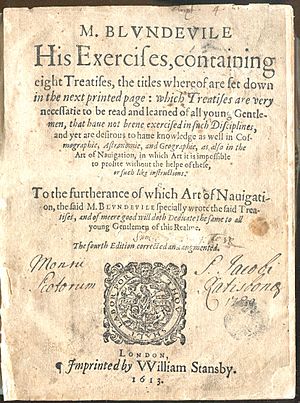Thomas Blundeville facts for kids
Thomas Blundeville (born around 1522, died around 1606) was an English writer and mathematician. He was a humanist, which means he believed in the importance of human values and education. Thomas Blundeville was known for his work on logic (the study of reasoning), astronomy (the study of stars and planets), education, and horsemanship (riding and training horses). He also translated many books from Italian into English.
Blundeville was interested in many different topics, and he always aimed for practical uses for his knowledge. He was one of the first writers to publish books in English on several subjects. He also invented a common tool used in geometry classes today: the protractor.
Contents
His Life Story
Thomas Blundeville lived as a country gentleman on his land in Newton Flotman, Norfolk. He inherited his father's estate in 1568. It's thought that he might have studied at the University of Cambridge.
He had connections with important people at the royal court and with smart thinkers in London. He worked with Henry Briggs, a mathematician at Gresham College. He also had the support of powerful nobles like Robert Dudley, 1st Earl of Leicester.
Blundeville was a math tutor for important families, including those of Nicholas Bacon and Francis Wyndham. Some historians believe he might have traveled to Italy because he knew a lot about Italian books.
He was married twice. Sadly, his son, Andrew, died in wars in Flanders. His daughter, Elizabeth, married Rowland Meyrick. Rowland's father, Sir Gelli Meyrick, was connected to Robert Devereux, 2nd Earl of Essex and faced trouble when the Earl did.
His Writings
Early Books
One of Blundeville's first books was a partial translation of Moralia by Plutarch. It was called Three Moral Treatises and came out in 1561. This book was published to celebrate Elizabeth I becoming queen.
Around 1560, he published The arte of ryding and breakinge greate horses. This was the very first book about equitation (horse riding) published in English! It was a shorter version of an Italian book by Federico Grisone, and it focused on using horses in war. He followed this with The fower chiefyst offices belonging to Horsemanshippe (1565–66). This book included an updated translation of Grisone's work and other writings.
Writing About History
Blundeville had clear ideas about how history should be written. He believed that history should explain the "means and instruments" (the causes and tools) behind events. He also thought that history moved in a "spiral" pattern, not just in a straight line or a simple circle. This meant that while some things repeat, there is also progress and change.
His book True Order and Methode was for the Earl of Leicester. It was a simplified translation of works by Jacopo Aconcio and Francesco Patrizzi. This book supported the idea of writing history in a realistic way, showing how things actually happened.
Logic Explained
His book Arte of Logike (written in 1575, published in 1599) taught about logic. It showed how to think clearly and solve problems. The book included a section on fallacies, which are mistakes in reasoning. For example, it discussed arguments about whether the Earth moves around the Sun or if the Sun moves around the Earth.
Science, Math, and Maps
Blundeville's later works focused on geography, navigation (how to steer ships), and travel. He believed that geography was very important for understanding history.
His book The Exercises (1594) brought together six different guides on practical skills. It tried to include the newest information available. For example, it described a world map published just two years earlier by Petrus Plancius. It also talked about new globes made by Emery Molyneux and tools like the cross-staff.
In The Exercises, Blundeville included math tables for trigonometry, which is a branch of math dealing with triangles. This was one of the first English books to introduce this topic.
A later version of The Exercises (1613) even showed the famous trips around the world made by Francis Drake and Thomas Cavendish.
He also worked on an astronomy book called The Theoriques of the Seuen Planets (1602). He got help from other smart people like Lancelot Browne and Edward Wright. This book even included new ideas about the Earth's magnetic field from William Gilbert.
Blundeville is known for inventing the protractor, a tool used to measure angles. He described a semicircular tool for measuring angles in his 1589 book, Briefe Description of Universal Mappes and Cardes.
Main Books by Blundeville
- A Very Brief and Profitable Treatise declaring how many Counsels and what name of Counsellors a Prince that will govern well ought to have (1570)
- The True Order and Methode of Wryting and Reading of Hystories (1574)
- M. Blundevile His Exercises (1594)
- Arte of Logike (1599)
- The Theoriques of the Seuen Planets (1602)


